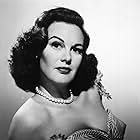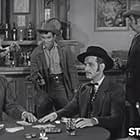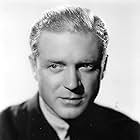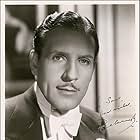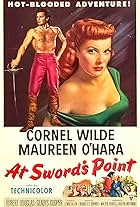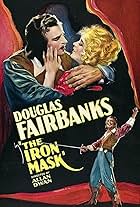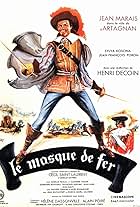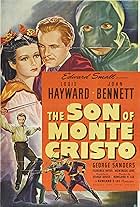A female version of 'The Man in the Iron Mask'. In this version, the mask is put on a princess (Patricia Medina) rather than a prince as in the original book by Alexandre Dumas.A female version of 'The Man in the Iron Mask'. In this version, the mask is put on a princess (Patricia Medina) rather than a prince as in the original book by Alexandre Dumas.A female version of 'The Man in the Iron Mask'. In this version, the mask is put on a princess (Patricia Medina) rather than a prince as in the original book by Alexandre Dumas.
Paul Cavanagh
- Undetermined Role
- (unconfirmed)
Marlo Dwyer
- Undetermined Role
- (uncredited)
Keith Hitchcock
- Chevalier La Porte
- (uncredited)
Esther Howard
- Madame Duprez
- (uncredited)
Tor Johnson
- Renac
- (uncredited)
Leo Mostovoy
- Undetermined Role
- (uncredited)
Gerald Oliver Smith
- Undetermined Role
- (uncredited)
- Director
- Writers
- All cast & crew
- Production, box office & more at IMDbPro
Storyline
Did you know
- TriviaBarbara Payton was fired by producer Walter Wanger a week before the film was scheduled to go into production, being replaced by Patricia Medina.
- ConnectionsReferenced in Moonlighting: The Lady in the Iron Mask (1985)
Featured review
When I started on this mini-Louis Hayward retrospective, I bemoaned the fact that the film under review was unavailable to me for assessment (at this point, I am now left with only THE ROYAL African RIFLES {1953} to catch up with from amongst the star's adventure outings); well, four days later, here I am writing about it! Blame it on the limitless, rapid-fire 21st century technology. I will say at the outset that the copy I landed was not only the most battered of the five but, worse still, that it was sourced from a black-and-white print when the film was originally released in a Cinecolor process dubbed "Naturalcolor"!! For the record, this odd practice is not as rare as one would think: I do recall a few occasions where films were broadcast on TV shorn of colour - one such example being Raffaello Matarazzo's epic THE SHIP OF CONDEMNED WOMEN (1953)...which I own but have yet to upgrade to its official version, even if it was made available eventually! Nevertheless, I am not one to look a gift horse in the mouth and, thankfully, I only realized the discrepancy after the fact so that my enjoyment was not marred by foreknowledge. This was now the fourth consecutive Louis Hayward-Patricia Medina pairing in two years and the third to be directed by Ralph Murphy; although the latter's first relevant effort, THE LADY AND THE BANDIT (1951) is easily the weakest of the quintet I have just watched, the stars must have hit it off with him since they retained his services in such quick succession and, in retrospect, improved on the end product with each reunion.
It must be said that, arguably, Louis Hayward's best screen vehicle was when he played the titular dual roles in James Whale's definitive 1939 version of THE MAN IN THE IRON MASK (where Warren William was D'Artagnan); needless to say, this is a retelling of the same tale - even if the opening credits state that it is actually based on "The Three Musketeers"! - with Hayward now taking on the role of the Fourth Musketeer and, most crucially, changing the sex of the imperiled royals! Obviously enough, it is Medina who now has to perform double duties and, as if it did not have the semblance of familiarity enough already, John Sutton returns from CAPTAIN PIRATE (1952) to fill in the boots of the aristocratic scoundrel pulling all the wrong strings behind the throne of France! For the record, the Three Musketeers are here enacted by Alan Hale, Jr. (Porthos), Steve Brodie (barely recognizable as Athos, decked out in an unbecoming wig for the most part and, at one point, amusingly seen in drag!!) and one Judd Holdren (Aramis)!; curiously, Hale Jr. had already portrayed Porthos, Jr. in the superior Technicolor adventure AT SWORD'S POINT and would go back to doing Porthos in the belated, star-studded remake of THE MAN IN THE IRON MASK itself, i.e. THE FIFTH MUSKETEER (1979)!
While I was happy to find three of Hayward's films that I just watched to be better than their muted reputation would have you believe, the same is (relatively) untrue for this one since, as can be intimated from some of my comments above, the end result emerges as rather a preposterous concoction. With this in mind, finding the name of prolific screenwriter Jack Pollexfen in the credits as both co-writer/executive producer makes sense since he was responsible for some pretty oddball cinematic reinventions of classic literary texts, namely THE SON OF DR. JEKYLL (1951; with Louis Hayward again), the aforementioned AT SWORD'S POINT, SON OF SINBAD (1955) and DAUGHTER OF DR. JEKYLL (1957), not to mention a few more I have yet to catch up with: TREASURE OF MONTE CRISTO (1949; a film noir, no less!), SWORD OF VENUS (1953; "Monte Cristo" country again) and RETURN TO TREASURE ISLAND (1954)!! Among the film's other credits one finds such distinguished names as producer Walter Wanger, cinematographer Ernest Laszlo and composer Dmitri Tiomkin, plus in the cast list, Lester Matthews (as the ailing French Prime Minister whose calling for D'Artagnan's intervention sets the narrative rolling), Tor Johnson (of all people – as a thuggish prison warden) and bits by John Dehner and Gavin Muir that barely register.
Among other clumsy elements within the movie are the fact that it opens with D'Artagnan shipbound for America (ostensibly in exile) reminiscing about what caused this predicament and, a few minutes into the flashback, having the PM go into one himself depicting the fateful circumstances of the two Medinas' birth; when entering the dungeon to free the imprisoned queen, D'Artagnan is conveniently accompanied by the burly Porthos – as if he knew they were going to be met with Tor Johnson's opposition!; after freeing her from captivity, Medina masquerades incognito as Hayward's page and, at one point, the couple are caught smooching by an understanding innkeeper!; D'Artagnan and the Queen halt their galloping carriage (which is running against time to stop the false royal from marrying the Spanish Prince – thus effectively putting a foreigner onto the French throne!) to argue about whether she should follow her heart (give it all up for true love) or her head (regain her rightful title)!!; eventually, Queen Medina does relinquish her throne in favour of her inexperienced twin to marry D'Artagnan only he thinks it is his beloved ordering him to marry her sister to enable her to carry out her royal duties after all!; the location of the all-important birthmark that identifies the true queen makes D'Artagnan blush when he hears about it...but when it is ultimately shown at the film's very end – thus revealing Medina's ruse – it is actually on her knee! Talk about an anti-climax!! Still, all in all, LADY IN THE IRON MASK is quite a serviceable romp with the expected plethora of horse chases, court intrigues and sword-and-fistfights that ensure an entertaining ride for undiscriminating viewers.
It must be said that, arguably, Louis Hayward's best screen vehicle was when he played the titular dual roles in James Whale's definitive 1939 version of THE MAN IN THE IRON MASK (where Warren William was D'Artagnan); needless to say, this is a retelling of the same tale - even if the opening credits state that it is actually based on "The Three Musketeers"! - with Hayward now taking on the role of the Fourth Musketeer and, most crucially, changing the sex of the imperiled royals! Obviously enough, it is Medina who now has to perform double duties and, as if it did not have the semblance of familiarity enough already, John Sutton returns from CAPTAIN PIRATE (1952) to fill in the boots of the aristocratic scoundrel pulling all the wrong strings behind the throne of France! For the record, the Three Musketeers are here enacted by Alan Hale, Jr. (Porthos), Steve Brodie (barely recognizable as Athos, decked out in an unbecoming wig for the most part and, at one point, amusingly seen in drag!!) and one Judd Holdren (Aramis)!; curiously, Hale Jr. had already portrayed Porthos, Jr. in the superior Technicolor adventure AT SWORD'S POINT and would go back to doing Porthos in the belated, star-studded remake of THE MAN IN THE IRON MASK itself, i.e. THE FIFTH MUSKETEER (1979)!
While I was happy to find three of Hayward's films that I just watched to be better than their muted reputation would have you believe, the same is (relatively) untrue for this one since, as can be intimated from some of my comments above, the end result emerges as rather a preposterous concoction. With this in mind, finding the name of prolific screenwriter Jack Pollexfen in the credits as both co-writer/executive producer makes sense since he was responsible for some pretty oddball cinematic reinventions of classic literary texts, namely THE SON OF DR. JEKYLL (1951; with Louis Hayward again), the aforementioned AT SWORD'S POINT, SON OF SINBAD (1955) and DAUGHTER OF DR. JEKYLL (1957), not to mention a few more I have yet to catch up with: TREASURE OF MONTE CRISTO (1949; a film noir, no less!), SWORD OF VENUS (1953; "Monte Cristo" country again) and RETURN TO TREASURE ISLAND (1954)!! Among the film's other credits one finds such distinguished names as producer Walter Wanger, cinematographer Ernest Laszlo and composer Dmitri Tiomkin, plus in the cast list, Lester Matthews (as the ailing French Prime Minister whose calling for D'Artagnan's intervention sets the narrative rolling), Tor Johnson (of all people – as a thuggish prison warden) and bits by John Dehner and Gavin Muir that barely register.
Among other clumsy elements within the movie are the fact that it opens with D'Artagnan shipbound for America (ostensibly in exile) reminiscing about what caused this predicament and, a few minutes into the flashback, having the PM go into one himself depicting the fateful circumstances of the two Medinas' birth; when entering the dungeon to free the imprisoned queen, D'Artagnan is conveniently accompanied by the burly Porthos – as if he knew they were going to be met with Tor Johnson's opposition!; after freeing her from captivity, Medina masquerades incognito as Hayward's page and, at one point, the couple are caught smooching by an understanding innkeeper!; D'Artagnan and the Queen halt their galloping carriage (which is running against time to stop the false royal from marrying the Spanish Prince – thus effectively putting a foreigner onto the French throne!) to argue about whether she should follow her heart (give it all up for true love) or her head (regain her rightful title)!!; eventually, Queen Medina does relinquish her throne in favour of her inexperienced twin to marry D'Artagnan only he thinks it is his beloved ordering him to marry her sister to enable her to carry out her royal duties after all!; the location of the all-important birthmark that identifies the true queen makes D'Artagnan blush when he hears about it...but when it is ultimately shown at the film's very end – thus revealing Medina's ruse – it is actually on her knee! Talk about an anti-climax!! Still, all in all, LADY IN THE IRON MASK is quite a serviceable romp with the expected plethora of horse chases, court intrigues and sword-and-fistfights that ensure an entertaining ride for undiscriminating viewers.
- Bunuel1976
- Mar 22, 2014
- Permalink
Details
- Release date
- Country of origin
- Language
- Also known as
- Die Frau mit der eisernen Maske
- Filming locations
- Production company
- See more company credits at IMDbPro
- Runtime1 hour 18 minutes
- Aspect ratio
- 1.37 : 1
Contribute to this page
Suggest an edit or add missing content

Top Gap
By what name was Lady in the Iron Mask (1952) officially released in Canada in English?
Answer









